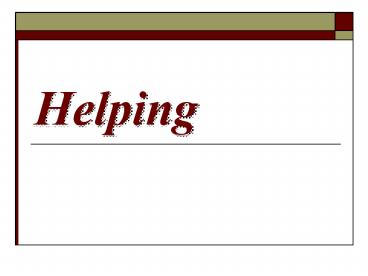Helping - PowerPoint PPT Presentation
Title:
Helping
Description:
Social Psychology Chapter 12: HELPING – PowerPoint PPT presentation
Number of Views:17
Title: Helping
1
Helping
2
Helping
- Why do we help?
- When will we help?
- Who will help?
- How can we increase helping?
3
Altruism
4
Altruism
- A motive to increase anothers welfare without
conscious regard for ones self-interests.
5
Egoism
6
Egoism
- A motive to increase ones own welfare.
7
1.) Why do we help?
8
Why do we help? (Theories)
- Social-exchange
- Social Norms
- Evolutionary Psychology
9
Social Exchange
10
Social-exchange theory
- the theory that human interactions are
transactions that aim to maximize ones rewards
and minimize ones costs.
11
Rewards
12
Rewards
- External rewards
- Internal rewards
13
Rewards
- External we give to get.
- Internal our sense of self-worth.
14
Internal Rewards (emotional state/personal
traits)
- Guilt
- Feel bad-do good
- Feel good-do good
15
Social Norms
16
Social Norms
- are social expectations.
- prescribes proper behavior.
17
Two Social Norms
- The Reciprocity Norm
- The Social-Responsibility Norm
18
Two Social Norms
- The Reciprocity Norm an expectation that people
will help, not hurt, those who have helped them. - The Social-Responsibility Norm an expectation
that people will help those needing help.
19
Gender and Receiving Help
20
Gender Receiving Help
- Women offered help equally to males and females,
whereas Men offered more help when the persons in
need were females.
21
Evolutionary Psychology
22
Evolutionary Psychology
- the study of the evolution of cognition and
behavior using the principles of natural
selection. - the theory contends that the essence of life is
survival.
23
Two types of self-sacrificial helping
(Evolutionary Psychology Theory)
- Kin Protection
- kin selection- the idea that evolution has
selected altruism towards ones close relatives
to enhance the survival of mutually shared genes. - Reciprocity
24
Comparison of Theories
Theory Level of Explanation Externally Helping Intrinsic Helping
Social-exchange Psychological External rewards for helping Inner rewards for helping
Social Norms Sociological Reciprocity norm Social-responsibility norm
Evolutionary Biological Reciprocity Kin selection
25
Genuine Altruism/Empathy
26
Empathy
- the vicarious experience of anothers feelings
putting oneself in anothers shoes.
27
(2) When will we help?
28
Number of Bystanders
- As the number of bystanders increases, any given
bystander is less likely to notice the incident,
less likely to assume responsibility for taking
action. - Lone bystanders were more likely to help.
29
Bystander effect
- The finding that a person is less likely to
provide help when there are other bystanders.
30
- Noticing/Interpreting
- Assuming Responsibility
31
Helping when someone else does
- Prosocial models do promote altruism.
- Example New Jersey shoppers were most likely to
drop money in a Salvation Army kettle if they had
seen someone else do the same.
32
Time Pressures
- A person not in a hurry may stop and offer help
to a person in distress. A person in a hurry is
likely to keep going. (Darley Batson -
Researchers)
33
Similarity
- We tend to help those whom we perceive as being
similar to us.
34
(3) Who will help?
35
Personality Traits
- Attitude and trait predict average behavior
across many situations more accurately. - Individual differences some people are
reliably more helpful.
36
Personality Traits
- Network traits those high in positive
emotionality, empathy self-efficacy are most
likely concerned and helpful. - Personality influences how particular people
react to particular situations.
37
Religious Faith
- Predicts long-term altruism, as reflected I
volunteerism charitable contributions.
38
(4) How can we increase helping?
39
3 ways to increase helping
- Reduce the ambiguity and increase responsibility.
- Use door-in-the-face effect technique to evoke
guilt feelings or concern for self-image. - Teach altruism.
40
- Door-in-the-face effect A strategy for gaining
a concession. - Overjustification effect the result of bribing
people to do what they already like doing they
may then see their actions as externally
controlled rather than intrinsically appealing.

